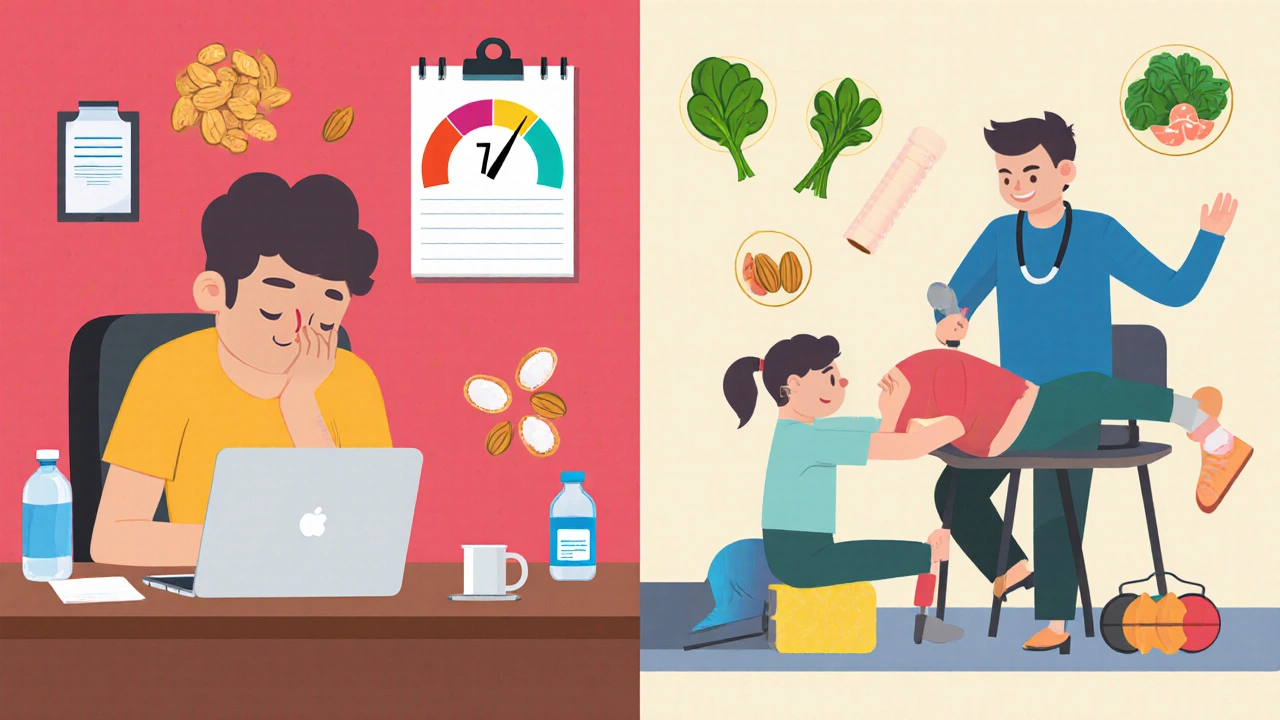How Muscle Aches Affect Quality of Life: A Personal Journey
 Oct, 17 2025
Oct, 17 2025
Muscle Ache Tracker & Management Tool
Track Your Muscle Ache
Imagine waking up and feeling a lingering throb in your shoulders, a tight knot in your lower back, or a vague soreness in your calves that doesn’t quit even after a good night’s sleep. That was my reality for months, and it forced me to rethink how a simple muscle ache can hijack almost every part of daily life.
What Exactly Is a Muscle Ache?
In plain terms, a muscle ache refers to a dull, lingering pain that originates within the muscle fibers themselves, often triggered by overuse, poor posture, or stress. Unlike a sharp cramp that spikes and fades, an ache sticks around, sometimes worsening with activity and easing only a little with rest.
Why It Matters: The Ripple Effect on Quality of Life
Living with constant muscle aches isn’t just about the physical discomfort. It seeps into sleep, work performance, emotional balance, and even social interactions.
- Sleep quality drops because the ache keeps the body in a semi‑alert state, making it hard to settle into deep REM cycles.
- Work productivity takes a hit when concentration drifts toward the next wave of pain, leading to missed deadlines or frequent breaks.
- Mood and mental health suffer as chronic discomfort fuels irritability and low motivation.
In my own case, the ache turned simple tasks-like grocery shopping or picking up a child-into calculations of “Can I manage this without it getting worse?” That mental load made me more anxious, which in turn amplified the pain, creating a vicious cycle.
Common Triggers That Fade In and Out
Understanding the root causes helps break the cycle. Here are the usual suspects I discovered through trial and error:
- Exercise intensity that exceeds the body’s current conditioning level. A sudden HIIT session after weeks of low‑impact walks left my thighs sore for days.
- Posture especially prolonged slouching at a desk. I spent hours hunched over my laptop, and my upper back turned into a permanent ache.
- Stress which raises cortisol and tightens muscles. Work pressure made my neck muscles tense, and the tension never fully relaxed.
- Dietary factors like low magnesium or dehydration. Skipping electrolytes after a sweaty workout made cramps more likely, which later morphed into aches.
Identifying which of these applied to you is the first step toward a tailored plan.

How to Gauge the Severity: The Pain Scale Toolbox
Not all aches are equal. I started using a simple 0‑10 pain scale each morning, noting the location, duration, and activities that worsened it. Tracking patterns revealed two key insights:
- On days I logged a score above 6, I was less likely to exercise, which then caused a dip in mood.
- Even a modest 3‑4 score mattered if it persisted for more than three nights, because sleep disruption compounded the overall burden.
Documenting pain doesn’t have to be fancy-just a notebook or a phone note can be enough to spot trends.
Managing Muscle Aches: A Toolkit That Actually Works
After months of trial, error, and a few frustrating setbacks, I settled on a multi‑layered approach that addresses the problem from several angles.
1. Gentle Movement and Stretching
Contrary to the instinct to “rest completely,” light activity keeps blood flowing and reduces stiffness. My go‑to routine includes:
- 5‑minute morning cat‑cow stretch for the spine.
- Dynamic leg swings before any cardio.
- Evening foam‑rolling focused on the calves, hamstrings, and upper back.
These moves take less than ten minutes but make a noticeable difference in how the ache feels the next day.
2. Over‑the‑Counter Pain Relievers
When the ache spikes, I reach for over‑the‑counter pain relievers such as ibuprofen or acetaminophen, used responsibly and for short periods. They help cut inflammation and give the body a brief window to recover.
Important tip: Always follow dosage guidelines and consider any personal health conditions before starting.
3. Professional Help: Physiotherapy
Seeing a physiotherapist provided targeted exercises, posture correction, and manual therapy that addressed the underlying muscular imbalances. After just four sessions, my posture improved, and the chronic lower‑back ache faded by about 40%.
4. Lifestyle Tweaks
Small shifts in daily habits can curb the triggers that start the ache cycle:
- Sleep hygiene: Keep the bedroom cool, limit screens, and aim for 7‑8 hours.
- Hydration: Aim for at least 2 liters of water a day, especially after workouts.
- Magnesium‑rich foods like almonds, spinach, and black beans help relax muscles.
- Stress management: Short breathing exercises or a 5‑minute mindfulness break during work reduced neck tension.
5. When to Seek Medical Advice
If you notice any of the following, it’s time to book a clinician:
- Pain that wakes you up at night.
- Sudden weakness or loss of sensation.
- Pain persisting longer than three weeks despite self‑care.
- Accompanied fever or swelling, which could signal infection.
Side‑by‑Side Comparison of Common Management Options
| Approach | Typical Cost (AU$) | Effectiveness (1‑10) | Pros | Cons |
|---|---|---|---|---|
| Gentle Stretching & Foam‑Rolling | 0‑5 (equipment) | 7 | Easy, no meds, improves flexibility | Requires consistency |
| OTC Pain Relievers | 5‑15 per month | 6 | Quick relief, widely available | Potential stomach issues, short‑term |
| Physiotherapy Sessions | 80‑120 per session | 8 | Tailored plan, addresses root cause | Higher cost, need appointments |
| Stress‑Reduction Techniques | 0‑30 (apps or classes) | 5 | Broad mental health benefits | Effect varies per individual |
| Medical Evaluation | 150‑300 (consult) | 9 | Rules out serious conditions | May involve tests, higher expense |
Key Takeaways
- A muscle ache is more than a minor nuisance; it can erode sleep, work, and mood.
- Identify personal triggers-exercise intensity, posture, stress, or diet-to break the pain loop.
- Use a simple pain‑scale log to monitor severity and spot trends.
- Combine gentle movement, appropriate OTC meds, physiotherapy, and lifestyle tweaks for the best relief.
- Seek professional medical help if pain persists, worsens at night, or is accompanied by other alarming symptoms.
Frequently Asked Questions
How long do muscle aches usually last?
Most mild aches fade within a few days if you rest, hydrate, and do gentle stretching. Persistent aches that linger beyond two weeks may need professional assessment.
Can diet really influence muscle pain?
Yes. Low magnesium, potassium, or dehydration can increase muscle cramping and soreness. Including leafy greens, nuts, bananas, and adequate water helps keep muscles relaxed.
Is it safe to use ibuprofen every day for aches?
Regular daily use is not recommended without a doctor’s guidance because it can irritate the stomach lining and affect kidney function. Short‑term, as‑needed use is generally safe.
What’s the difference between a cramp and a muscle ache?
A cramp is a sudden, intense contraction that lasts seconds to minutes, while an ache is a persistent, dull discomfort that can last hours or days.
Can physiotherapy prevent future aches?
Yes. A physiotherapist can teach you proper movement patterns, strengthen weak muscle groups, and adjust posture, which reduces the likelihood of recurring aches.
Living with muscle aches taught me that pain isn’t just something that lives in the body-it lives in the schedule, the mindset, and the choices you make each day. By mapping triggers, tracking severity, and applying a mix of self‑care and professional help, you can reclaim the quality of life that aches try to steal.

Alexis Howard
October 17, 2025 AT 12:32I doubt most of this so‑called “muscle ache” guide actually helps anyone
Darryl Gates
October 28, 2025 AT 20:06Hey, good job breaking down the triggers. Tracking your pain on a 0‑10 scale is a solid habit, and adding a quick cat‑cow stretch each morning can improve spinal mobility. Consistent foam‑rolling before bed also helps flush out metabolic waste that builds up after workouts. Keep the hydration and magnesium in check – those electrolytes are often the silent culprits.
Joanna Mensch
November 9, 2025 AT 04:40Ever notice how the pharma industry loves to push OTC pain meds as the ultimate fix? It feels like they’re profiting off our discomfort while keeping the real root causes hidden. Stay skeptical and look for natural ways to support muscle recovery.
Nickolas Mark Ewald
November 20, 2025 AT 13:14Sounds good. Simple stretches and staying hydrated are easy things anyone can try.
Roberta Makaravage
December 1, 2025 AT 21:49Honestly, the science backs most of these steps. 🧠🦵 A balanced diet with magnesium, regular low‑impact movement, and proper sleep hygiene creates a synergistic effect that far outweighs any single remedy. The evidence shows that multi‑modal approaches score an 8‑9 on effectiveness scales. 🔬💪
Lauren Sproule
December 13, 2025 AT 06:23Nice points! Just a friendly reminder to keep the tone inclusive – we all defintely benefit from sharing what works.